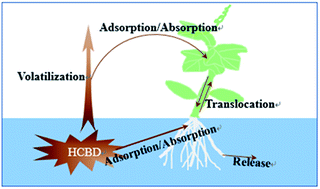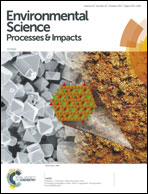Bioaccumulation of hexachlorobutadiene in pumpkin seedlings after waterborne exposure†
Abstract
Hexachlorobutadiene (HCBD) has been listed as a persistent organic pollutant (POP) in the Stockholm Convention, and is now drawing more and more research interest. However, the understanding of its bioaccumulation, especially in plants, is still very limited. In this work, the behavior of HCBD in aqueous solution and pumpkin seedlings was studied through in-lab hydroponic exposure experiments. It was found that 69% of HCBD volatilized from water to the atmosphere after one day of exposure, and only 1% remained in the solution after four days. This high volatility might be the main cause of the low HCBD levels in aqueous environments. Although a great amount of HCBD volatilized into the atmosphere, only a small proportion of airborne HCBD was captured by the leaves and stems of the blank pumpkin seedling controls. The translocation of HCBD from the leaves to the bottom roots, as well as its release from the roots into the water, was detected. For the exposure groups, the pumpkin seedlings absorbed HCBD from both the hydroponic solution and the air via the roots and leaves, respectively. The concentration of HCBD in the exposed pumpkin roots linearly increased with the continuous addition of HCBD into the exposure system. Upward translocation from the roots to the leaves and downward translocation from the leaves to the roots existed simultaneously in the exposed pumpkin seedlings. However, the concentrations of HCBD in the leaves, stems and roots in the exposure group were much higher than those of the blank plant controls, suggesting little contribution from the airborne HCBD in the hydroponically exposed pumpkin seedlings. The lipid content did not show obvious effects on the bioaccumulation and biodistribution of HCBD in the pumpkin seedlings, indicating that the translocation of HCBD within the pumpkin seedlings might be an active process. This study provided new findings on the environmental behavior of HCBD, which will be helpful for understanding the exposure risks.



 Please wait while we load your content...
Please wait while we load your content...